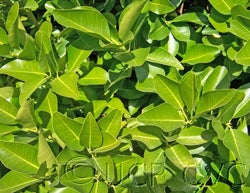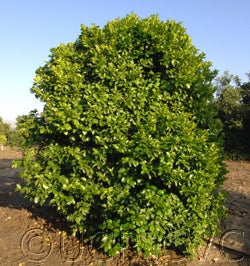Indian atalantia
CRC 4189
PI 600636
Source
Received as seed from Malaysia, 1991.
Parentage/origins
Bukit Sedanan Forest Reserve, Jasin District.
Rootstocks of accession
Own roots.
Season of ripeness at Riverside
Has not been observed.
Notes and observations
"...Derived from wild plants collected on August 19, 1990 at Bukit Sedanan Forest Reserve, Jasin District, Melaka, West Malaysia." (letter from D.T. Jones to T.E. Williams dated August 24, 1990.
Description from The Citrus Industry Vol. 1 (1967)
"A small, much-branched tree with rounded twigs usually slightly hairy at first, becoming glabrous, with single, stout, sharp spines, 10-15 or 20 mm long, or unarmed; leaves bright green above, paler and reticulate-veined below, ovate-lanceolate or elliptical, variable in size, 3-15 X 2-4 cm (usually 4-8 or 10 X 2.5-3.5 cm), margins entire or slightly undulate, apices obtusely rounded, often emarginate, bases broadly cuneate, articulated with the wingless petioles that are 5-10 mm long and 1.5-2 mm wide, flattened above, veins strongly marked on the under surface, 10-14 on each side, branched, forming reticulate veinlets and also forked near the margins and anastomosing; flowers long-pediceled on short racemes (or clustered) in the axils of the leaves, pedicels 6-15 mm long, finely pubescent or glabrous, merging into the calyx; calyx more or less irregularly and deeply 2-cleft, and glabrous or finely pubescent; corolla 4-5-merous, petals white, glabrous, bluntly rounded at apex, 8-10 mm long; stamens 8-10, united into a tube 6-8 mm long with the anthers borne on the free tips of the filaments; pistil slender, 6-7 X 1 mm, ending in an abruptly expanded, 3-4-lobed stigma, 1.2-1.5 mm diam.; style caducous; fruits globose, 1.5-2 cm diam., yellowish-green when ripe, locules filled with numerous cuneate, sessile pulp-vesicles which are broad-based and tapering to a point at their free end, toward the center of fruit; seeds usually only 1 to a locule; often some of the locules do not develop seeds.
The most remarkable character of this species (found also in the closely related species A. macrophylla) is its very curious calyx. This is a hollow, balloon-like envelope, not articulated with the pedicel and without any sign of sepals. Soon this undifferentiated envelope splits more or less irregularly into 2 (rarely 3) lobes, and exposes the corolla, stamens, and pistil to view.
The nomenclature of this species is in a confused state. Limonia monophylla of Linnaeus has been assumed by almost all taxonomists to be this species. However, Trimen (1893, p. 227) listed L. monophyllaL. as a synonym of Atalantia ceylanica, and stated that "the figure of Burmann [1737, pl. 65, fig. l]…appears to represent this rather than A. monophylla…Hermann's specimen…is certainly A. zeylanica[ceylanica]." Airy-Shaw (1939, p. 291) again examined Hermann’s specimen (which is in fact the type specimen of Limonia monophyllaL.) in the British Museum and saw no reason to doubt Trimen's findings. Airy-Shaw then showed that A. monophylla was based by De Candolle expressly on "Limonia monophylla Linn." of Roxburgh (1795, vol. 1, pp. 59-60, pl. 83) and that L. monophylla L. was not cited. However, the plant described and figured by Roxburgh was certainly not A. ceylanica and hence was not Limonia monophylla L. Airy-Shaw assumed that Roxburgh's plant from the Coromandel Coast was, in fact, A. monophylla as understood by Hooker (1875, p. 511), and accepted the name A. monophylla DC. for it. However, Roxburgh described and figured a plant having a "four-five parted" calyx, a character not found in A. monophylla as understood by Hooker. That species has, instead of a normal calyx, a bladder-like continuous membrane covering the flower bud which, as the bud expands, splits irregularly. Possibly both Roxburgh and the artist who made the beautiful colored plate of the Coromandel plant failed to see the irregularly ruptured calyx and, without careful study, assumed that it was 4- or 5-parted as in most of the other species of Atalantia and other related genera. Roxburgh described the leaves as "end-nicked" and "from two to three inches long, and one or one and a half broad"; nevertheless he published a plate showing a flowering branch with 23 leaves, none of them emarginate at the apex, measuring 1 7/8 to 2 9/16 inches long, and 5/8 to 1 1/16 inches wide, only one leaf slightly exceeding the minimum width given in the description and more than three-fourths of them narrower than 1 inch! In view of these facts, no great importance should be attached to the fact that neither Roxburgh nor the artist noticed at that time the abnormal splitting of the calyx, something no botanist had noticed in any species of Atalantia or in any other plant belonging to the orange subfamily.
For the present, it seems best to assume that Roxburgh was describing and figuring the true A. monophylla of Hooker and that A. monophylla DC. is the oldest valid name for it.
Atalantia monophylla has very hard wood that has been recommended as a substitute for boxwood (Gamble, 1915). The fruits are said to yield a warm oil used in treating chronic rheumatism by native doctors. One Indian author (Nadkani) stated that the fruits "make a nice pickle" (Lewis, 1934, p. 80).
When watered frequently, this species makes a luxuriant growth in the greenhouse. It should be tested as a hedge plant in warm subtropical climates and in dooryard gardens as an ornamental, since it has dense deep-green evergreen foliage and bears a great profusion of fragrant flowers and many small globose yellow fruits. Atalantia monophylla can be grafted on Citrus, and vice versa."
Availability
Not commercially available in California.
USDA Germplasm Resources Information Network page for Atalantia monophylla

